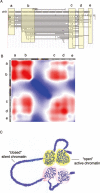Characterization of genome-wide enhancer-promoter interactions reveals co-expression of interacting genes and modes of higher order chromatin organization
- PMID: 22270183
- PMCID: PMC3292289
- DOI: 10.1038/cr.2012.15
Characterization of genome-wide enhancer-promoter interactions reveals co-expression of interacting genes and modes of higher order chromatin organization
Abstract
Recent epigenomic studies have predicted thousands of potential enhancers in the human genome. However, there has not been systematic characterization of target promoters for these potential enhancers. Using H3K4me2 as a mark for active enhancers, we identified genome-wide EP interactions in human CD4(+) T cells. Among the 6 520 long-distance chromatin interactions, we identify 2 067 enhancers that interact with 1 619 promoters and enhance their expression. These enhancers exist in accessible chromatin regions and are associated with various histone modifications and polymerase II binding. The promoters with interacting enhancers are expressed at higher levels than those without interacting enhancers, and their expression levels are positively correlated with the number of interacting enhancers. Interestingly, interacting promoters are co-expressed in a tissue-specific manner. We also find that chromosomes are organized into multiple levels of interacting domains. Our results define a global view of EP interactions and provide a data set to further understand mechanisms of enhancer targeting and long-range chromatin organization. The Gene Expression Omnibus accession number for the raw and analyzed chromatin interaction data is GSE32677.
Figures







Similar articles
-
High-resolution profiling of histone methylations in the human genome.Cell. 2007 May 18;129(4):823-37. doi: 10.1016/j.cell.2007.05.009. Cell. 2007. PMID: 17512414
-
Bridging between Mouse and Human Enhancer-Promoter Long-Range Interactions in Neural Stem Cells, to Understand Enhancer Function in Neurodevelopmental Disease.Int J Mol Sci. 2022 Jul 19;23(14):7964. doi: 10.3390/ijms23147964. Int J Mol Sci. 2022. PMID: 35887306 Free PMC article.
-
Three-dimensional genome architectural CCCTC-binding factor makes choice in duplicated enhancers at Pcdhα locus.Sci China Life Sci. 2020 Jun;63(6):835-844. doi: 10.1007/s11427-019-1598-4. Epub 2020 Apr 2. Sci China Life Sci. 2020. PMID: 32249388
-
Enhancer selectivity in space and time: from enhancer-promoter interactions to promoter activation.Nat Rev Mol Cell Biol. 2024 Jul;25(7):574-591. doi: 10.1038/s41580-024-00710-6. Epub 2024 Feb 27. Nat Rev Mol Cell Biol. 2024. PMID: 38413840 Free PMC article. Review.
-
Eukaryotic enhancers: common features, regulation, and participation in diseases.Cell Mol Life Sci. 2015 Jun;72(12):2361-75. doi: 10.1007/s00018-015-1871-9. Epub 2015 Feb 26. Cell Mol Life Sci. 2015. PMID: 25715743 Free PMC article. Review.
Cited by
-
Predicting links between tumor samples and genes using 2-Layered graph based diffusion approach.BMC Bioinformatics. 2019 Sep 9;20(1):462. doi: 10.1186/s12859-019-3056-2. BMC Bioinformatics. 2019. PMID: 31500564 Free PMC article.
-
Stress Conditions Modulate the Chromatin Interactions Network in Arabidopsis.Front Genet. 2022 Jan 5;12:799805. doi: 10.3389/fgene.2021.799805. eCollection 2021. Front Genet. 2022. PMID: 35069698 Free PMC article.
-
Nucleosome eviction and multiple co-factor binding predict estrogen-receptor-alpha-associated long-range interactions.Nucleic Acids Res. 2014 Jun;42(11):6935-44. doi: 10.1093/nar/gku327. Epub 2014 Apr 29. Nucleic Acids Res. 2014. PMID: 24782518 Free PMC article.
-
Systematic dissection of transcriptional regulatory networks by genome-scale and single-cell CRISPR screens.Sci Adv. 2021 Jul 2;7(27):eabf5733. doi: 10.1126/sciadv.abf5733. Print 2021 Jul. Sci Adv. 2021. PMID: 34215580 Free PMC article.
-
Transcriptional Enhancers in the Regulation of T Cell Differentiation.Front Immunol. 2015 Sep 9;6:462. doi: 10.3389/fimmu.2015.00462. eCollection 2015. Front Immunol. 2015. PMID: 26441967 Free PMC article. Review.
References
Publication types
MeSH terms
Substances
Associated data
- Actions
Grants and funding
LinkOut - more resources
Full Text Sources
Other Literature Sources
Molecular Biology Databases
Research Materials

